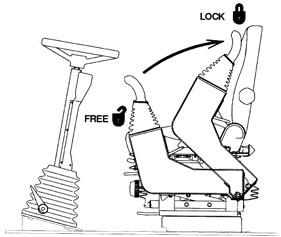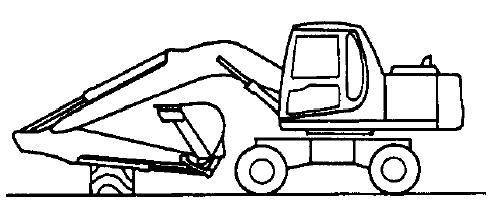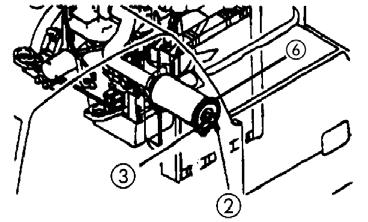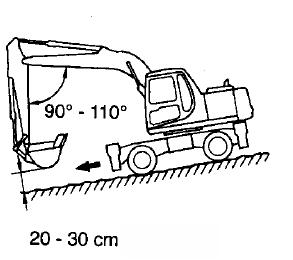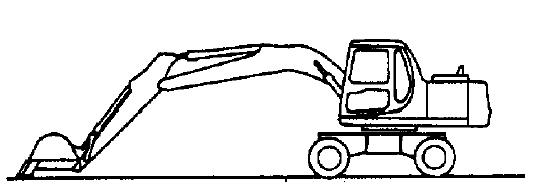
16 minute read
PRECAUTION DURING OPERATION
WARNING: For reasons of safety, always follow these safety precautions..
BEFORE STARTING ENGINE
SAFETY AT WORKSITE
Before starting the engine, thoroughly check the area for any unusual conditions that could be dangerous.
Before starting the engine, examine the terrain and soil conditions of the worksite. Determine the best and safest method of operation.
Make the slope as horizontal as possible before continuing operations.
If you need to operate on a street, protect pedestrians and cars by designating a person for worksite traffic duty or by installing fences around the worksite.
If water lines, gas lines, and high-voltage electrical lines may be buried under the worksite, contact each utility and identify their locations. Be careful not to sever or cut any of these lines.
Check the depth and flow of water before operating in water or crossing a river. NEVER be in water which is in excess of the permissible water depth.
Permissible water depth, see “PRECAUTIONS FOR OPERATION” on page 132.
FIRE PREVENTION
Thoroughly remove wood chips, leaves, paper and other flammable things accumulated on the engine compartment. They could cause a fire.
Check fuel, lubrication, and hydraulic systems for leaks. Have any leaks repaired. Wipe up any excess oil, fuel or other flammable fluids.
Check point, see “WALK-AROUND CHECK” on page 104.
Be sure a fire extinguisher is present and working.
IN OPERATOR’S CAB
Do not leave tools or spare parts lying around in the operator’s compartment. They may damage or break the control levers or switches. Always put them in the tool box on the front right side of the revolving frame or in the tool boxes on the undercarriage.
Keep the cab floor, controls, steps and handrails free of oil, grease, snow, and excess dirt.
WARNING: Failure to follow these safety precautions may lead to a serious accident.
VENTILATION FOR ENCLOSED AREAS
If it is necessary to start the engine within an enclosed area, provide adequate ventilation. Exhaust fumes from the engine can KILL.
PRECAUTIONS FOR MIRRORS, WINDOWS AND LIGHTS
Remove all dirt from the surface of the windows and lights to ensure that you can see well.
Adjust the rear view mirror so that you can see clearly from the operator’s seat, and always keep the surface of the mirror clean. If any glass is broken, replace it with a new part.
Check that the head lamps and working lamps are installed to match the operating conditions. Check also that they light up properly.
OPERATING MACHINE
WHEN STARTING THE ENGINE
Walk around for machine again just before mounting it, to check for people and objects that might be in the way.
NEVER start the engine if a warning tag has been attached to the wrist control.
Before starting the engine, sound the horn as an alert.
Start and operate the machine only while seated.
Do not allow anyone other than the operator to ride in the cab or on the machine body.
For machines equipped with a reverse alarm buzzer, check that the warning device operates correctly.
CHECK DIRECTION BEFORE STARTING MACHINE
Before operating the travel lever, check the direction of the under carriage. If the fixed axle is at the front, the forward/reverse pedal and steering will function in the opposite direction.
A Fixed axle
B Oscillating axle
Travel operations see “MOVING MACHINE OFF” on page 122.
A B
WARNING: For reasons of safety, always follow these safety precautions..
CHECK THAT NO ONE IS IN THE AREA BEFORE SWINGING OR TRAVELLING IN REVERSE
Always position a signalman when operating in dangerous places or places where the view is not clear.
Make sure that no one comes inside the swing radius or direction of travel.
Before starting to move, sound the horn or give a signal to warn people not to come close to the machine.
There are blind spots behind the machine, so if necessary, swing the upper structure to check that there is no one behind the machine before travelling in reverse.
PRECAUTIONS WHEN TRAVELLING
Fold in the work equipment as shown in the diagram below, and keep it at a height of 40-50 cm from the ground level before starting to travel.
When travelling on public roads the control lever pad safety lock should be down and the control lever lock switch, in the off position. This prevents operation of the control levers and activates the rear facing brake lamp circuit.
When travelling on rough ground, travel at low speed, and avoid sudden changes in direction.
Avoid travelling over obstacles as far as possible. If the machine has to travel over an obstacle, keep the work equipment as close to the ground as possible and travel at low speed. Never travel over obstacles which make the machine tilt strongly (10° or more). INCORRECT
A0067200PW
A0067190PW
AM089000PW
AM089010PW
WARNING: Failure to follow these safety precautions may lead to a serious accident.
TRAVELLING ON SLOPES
Travelling on hills, banks or slopes that are steep could result in the machine tipping over or slipping.
On hills, banks or slopes, carry the bucket closer to the ground, approximately 20 to 30 cm above the ground. In case of emergency, quickly lower the bucket to the ground to help the machine stop and prevent it from tipping over.

Downhill
Do not turn on slopes or travel across slopes. Always go down to a flat place to perform these operations.
Method of travelling on slopes, see “PRECAUTIONS WHEN TRAVELING UP OR DOWN HILLS” on page 133. Uphill
Do not travel up and down on grass, fallen leaves, and wet steel plates. These materials may allow the machine to slip, if it is travelling sideways. Keep travel speed very low.
INCORRECT

CORRECT
PROHIBITED OPERATIONS
Do not dig the work face under an overhang. This may cause the overhang to collapse and fall on top of the machine
Do not carry out deep digging under the front of the machine. The ground under the machine may collapse and cause the machine to fall.
INCORRECT

INCORRECT
WARNING: For reasons of safety, always follow these safety precautions..
DO NOT GO CLOSE TO HIGH-VOLTAGE CABLES
Going close to high-voltage cables can cause electric shock. Always maintain the safe distance given below between the machine and the electric cable.
The following actions are effective in preventing accidents. 1) Wear shoes with rubber or leather soles. 2) Use a signalman to give warning if the machine approaches too close to the electric cable.
If the work equipment should touch the electric cable, the operator should not leave the operator’s compartment.
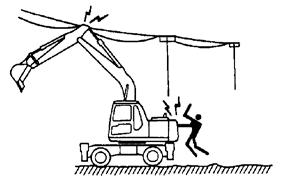
When carrying out operations near high voltage cables, do not let anyone come close to the machine.
Check with the electricity company about the voltage of the cables before starting operations.
Voltage Min. safety distance
6.6 kV 3 m
33.0 kV 4 m
66.0 kV 5 m
154.0 kV 8 m
275.0 kV 10 m
DO NOT HIT WORK EQUIPMENT
When working in places where there are height limits, such as in tunnels, under bridges, under electric cables, or in garages, be extremely careful not to hit the boom or arm.
ENSURE GOOD VISIBILITY
When working in dark places, install working lamps and head lamps, and set up lighting in the work area if necessary.
Stop operations if the visibility is poor, such as in mist, snow, or rain, and wait for the weather to improve to a condition that allows the operation to be carried out safely.
OPERATE CAREFULLY ON SNOW
When working on snow or icy roads, even a slight slope may cause the machine to slip to the side, so always travel at low speed and avoid sudden starting, stopping, or turning.
When there has been heavy snow, the road shoulder and objects placed beside the road are buried in the snow and cannot be seen, so always carry out snow-clearing operations carefully.
WARNING: Failure to follow these safety precautions may lead to a serious accident.
WORKING ON LOOSE GROUND
Avoid operating your machine too close to the edge of cliffs, overhangs, and deep ditches. If these areas collapse, your machine could fall or tip over and result in serious injury or death. Remember that the soil after heavy rain or blasting is weakened in these areas.
Earth laid on the ground and the soil near ditches are loose. They can collapse under the weight or vibration of your machine.
Install the HEAD GUARD (FOPS) if working in areas where there is danger of falling rocks and dirt.
DO NOT HIT THE OPERATOR CAB (for two piece boom only)
When the second boom cylinder is retracted, the bucket or the attachment can hit the operator cab or chassis.
Operate work equipment slowly and carefully to avoid any injury and damage.
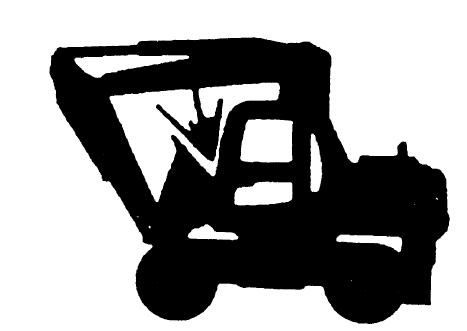
OPERATIONS ON SLOPES
When working on slopes, there is danger that the machine may lose its balance and turn over when the swing or work equipment are operated. Always carry out these operations carefully.
Do not swing the work equipment from the uphill side to the downhill side when the bucket is loaded. This operation is dangerous. (See the upper diagram on the right.)
If the machine has to be used on a slope, pile the soil to make a platform that will keep the machine as horizontal as possible. (See the lower diagram on the right.)
Piled soil on slope see “PRECAUTIONS WHEN TRAVELING UP OR DOWN HILLS” on page 133. INCORRECT
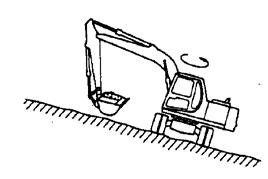
CORRECT

Platform
WARNING: For reasons of safety, always follow these safety precautions..
PARKING THE MACHINE
Park on level ground whenever possible. If not possible, chock the wheels, lower the bucket to the ground and thrust the bucket in the ground.
When parking on public roads, provide fences and signs, such as flags or lights, on the machine to warn passersby to be careful. Be sure that the machine, flags or lights do not obstruct traffic.
Parking procedure, see “PARKING MACHINE” on page 139.
When leaving the machine, lower the work equipment completely to the ground, raise the control lever Pad Safety lock to the LOCK position, then stop the engine and use the key to lock all the equipment. Always take the key with you.
Work equipment posture, see “PARKING MACHINE” on page 139. Places to lock, see “LOCKING” on page 141. CORRECT
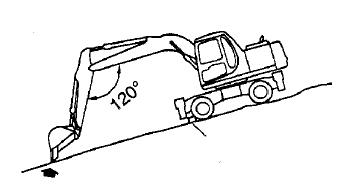
Chock Trust the bucket

TRANSPORTATION
LOADING AND UNLOADING
Loading and unloading the machine always involves potential hazards. EXTREME CAUTION SHOULD BE USED. When loading or unloading the machine, run the engine at low idling and travel at low speed.
Perform loading and unloading on firm, level ground only. Maintain a safe distance from the edge of a road.
ALWAYS block the wheels of the hauling vehicle and place blocks under both ramps before loading and unloading. Distance between ramps
ALWAYS use ramps of adequate strength. Be sure the ramps are wide and long enough to provide a safe loading slope.
Be sure that the ramps are securely positioned and fastened, and that the two sides are at the same level as one another.
Be sure the ramp surface is clean and free of grease, oil, ice and loose materials. Remove dirt from the machine wheels.
NEVER correct your steering on the ramps. If necessary, drive away from the ramps and climb again.
Swing the upper structure with extreme care on the trailer to Ramp
Block
avoid a possible accident caused by body instability. Blocks
AD052900B
WARNING: Failure to follow these safety precautions may lead to a serious accident.
After loading, block the machine wheels and secure the machine with tie-downs.
Loading and unloading, see “TRANSPORTATION” on page 147.
SHIPPING
When shipping the machine on a hauling vehicle, obey all state and local laws governing the weight, width, and length of a load. Also obey all applicable traffic regulations.
Determine the shipping route while taking into account the width, height and weight of the load.
BATTERY
BATTERY HAZARD PREVENTION
Battery electrolyte contains sulphuric acid and can quickly burn the skin and eat holes in clothing. If you spill acid on yourself, immediately flush the area with water.
Battery acid could cause blindness if splashed into the eyes. If acid gets into the eyes, flush them immediately with large quantities of water and see a doctor at once.
If you accidentally drink acid, drink a large quantity of water or milk, beaten egg or vegetable oil. Call a doctor or poison prevention centre immediately.
When working with batteries. ALWAYS wear safety glasses or goggles.
Batteries generate hydrogen gas. Hydrogen gas is very EXPLOSIVE, and is easily ignited with a small spark or flame.
Before working with batteries, stop the engine and turn the starting switch to the OFF position.
Avoid short-circuiting the battery terminals through accidental contact with metallic objects, such as tools, across the terminals.
When removing or installing, check which is the positive (+) terminal and negative (-) terminal.
Tighten the battery cap securely.
Tighten the battery terminals securely. Loosened terminals can generate sparks and lead to an explosion.
When removing battery cap wear rubber groves to prevent electrolyte contact with skin.
WARNING: For reasons of safety, always follow these safety precautions..
STARTING WITH BOOSTER CABLES
ALWAYS wear safety glasses or goggles when starting the machine with booster cables. INCORRECT
When starting from another machine, do not allow the two machines to touch.
Be sure to connect the positive (+) cable first when installing the booster cables. Disconnect the ground or negative (-) cable first when removing them.
If any tool touches between the positive (+) terminal and the chassis, it will cause sparks. This is dangerous, so be sure to work carefully.
Connect the batteries in parallel: positive to positive and negative to negative.
When connecting the ground cable to the frame of the machine to be started, be sure to connect it as far as possible from the battery.
Starting with booster cables, see “IF BATTERY IS DIS
CHARGED” on page 160.
TOWING
WHEN TOWING, ATTACH WIRE TO FRAME
Injury or death could result if a disabled machine is towed incorrectly.
If you machine is towed by another machine, ALWAYS use a wire rope with a sufficient towing capacity.
NEVER allow a disabled machine to be towed on a slope.
Do not use a chinked or frayed wire rope.
Do not straddle the towing cable or wire rope.
When connecting up a towing machine, do not let anyone enter the area between the towing machine and the equipment being towed.
Set the towing machine and the towing connection of the equipment being towed in a straight line when connecting it.
Place pieces of wood between the wire ropes and body to protect them from wear of damage.
Never tow the machine using the light-duty towing hole.
Towing method, see “METHOD OF TOWING MACHINE” on page 159.
When towing the machine without the engine running or in the advent of loss of hydraulic pressure, its is necessary to manually release the park brake, as follows. Towing holes

A0067320A
Undercarriage
WARNING: Failure to follow these safety precautions may lead to a serious accident.
View on transmission from front
Releasing the park brake before towing:
1. Unscrew the lock nuts on the park brake release bolts (A) completely (3 places).
2. Screw in the park brake release bolts (A) until the torque increases sharply. The park brake is now released.
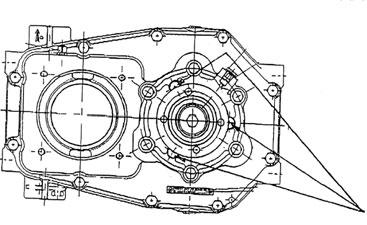
Resetting the park brake (A) after towing:
1. Unscrew the park brake release bolts (A) completely.
2. Screw in the park brake release bolts by hand until a contact can be felt at the bolt end. Lock the bolts with the lock nuts.
BUCKET WITH HOOK OR BUCKET LINK
GENERAL PRECAUTIONS
SPECIAL HOOK
When carrying out lifting work, the special lifting hook is or lifting eye is necessary.
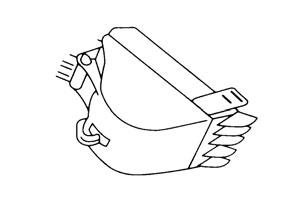
The following operations are prohibited.
Lifting loads with a wire rope fitted around the bucket teeth.
Lifting loads with the wire rope wrapped directly around the boom or arm.
CHECKING HOOK
When lifting a load, carry out the following checks to confirm that there is no abnormality before starting operations.
Check that there are no cracks or deformation in the lifting equipment.
Check that there is no abnormality in the stopper device.
HOOKING WIRE ROPE SECURELY TO HOOK
When performing lifting operation, securely hook the wire rope onto the special lifting hook or lifting eye. A

WARNING: For reasons of safety, always follow these safety precautions..
PRECAUTIONS FOR MACHINE INSTALLATION
After carrying out a preliminary inspection of ground conditions, select a flat, solid location. Confirm that the machine can be safely operated without toppling or rolling.
PROHIBITED OPERATIONS OTHER THAN MAIN APPLICATIONS
When performing lifting operation, never raise or lower a person.
NO PERSONS SHALL BE PERMITTED TO ENTER THE WORKING AREA
Due to the possible danger of the load falling or of collision with the load, no persons shall be allowed in the working area.
OPERATION SUPERVISOR
Before performing lifting operation, designate an operation supervisor. Always execute operation according to his instructions.
Execute operating methods direction. and procedures under his
Select a person responsible for signalling. Operate only on signals given by such person.
HANDLING OF WIRE ROPES ETC.
Wear leather gloves when handling wire ropes.
HANDLING OF FLUIDS
Some oils and other fluids, such as Antifreeze, can be harmful to you and the environment, you should therefore always follow the manufacturers instructions regarding storage, handling and disposal.
HANDLING OF USED ENGINE OILS
Avoid contact with used engine oils.
Refer to engine oils data sheet for handling and storage precautions.
HANDLING OF OILS
For diesel oils, hydraulic oils and oils used in the swing machinery, PTO, transmission axles and hubs avoid prolonged or frequent contact with skin.
Refer to manufacturers data sheet for handling and storage precautions.
WARNING: Failure to follow these safety precautions may lead to a serious accident.
HANDLING OF FLUIDS
For antifreeze and grease refer to manufacturers data sheet for handling and storage precautions.
PROTECTING EYES
Some oils and fluids can damage eyes. Refer to manufactured data sheet for handling and storage instructions.
PRECAUTIONS FOR LIFTING OPERATION
GRADUAL LIFTING OPERATION
When carrying out lifting operations, run the engine at low idling and use the L.O. (lifting operation mode).
Avoid sudden lever shifting and acceleration.
Swing speed is three to four times that of movable cranes. Therefore, be especially careful when performing swing operation.
NEVER LEAVE THE OPERATOR’S SEAT
Never leave the operator’s seat while lifting a load.
NEVER CARRY OUT EXCESSIVE OPERATIONS
Operation exceeding machine performance may result in accident or failure.
Carry out lifting operation within specified load limit.
Never carry out operations which may damage the machine such as overload or over-impact-load.
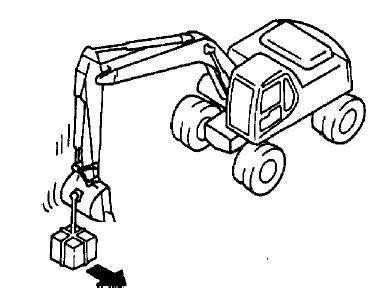
INCORRECT
Never drag a load laterally or longitudinally, nor retract the arm, otherwise, a dangerous situation may result.
NEVER TRAVELLING WHILE LIFTING A LOAD
Never travel while carrying a load.
OPERATING POSTURE
If the machine posture is not correct, the wire ropes or ring may detach from the hook. Confirm that the hook angle is correct to avoid this.

INCORRECT

